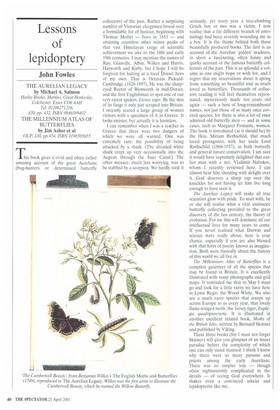Lessons of lepidoptery
John Fowles
THE AURELIAN LEGACY by Michael A. Salmon
Harley Books, Martins, Great Horkesley, Colchester, Essex CO6 4AH Tel: 01206271216, £30, pp. 432, ISBN 0946589402 THE MILLENNIUM ATLAS OF BUTTERFLIES by Jim Asher et al OUP, £30, pp.454, ISBN 0198505655
his book gives a vivid and often rather amusing account of the great Aurelians (bug-hunters or determined butterfly collectors) of the past. Rather a surprising number of Victorian clergymen brood over a formidable list of honour, beginning with Thomas Moffet — born in 1653 — and attaining countless other minor peaks of that vast Himalayan range of scientific achievement we owe to the 18th and early 19th centuries. I may mention the names of Ray, Glanville, Albin, Wilkes and Harris, Hayworth and Kirby, but I hope I will be forgiven for halting at a local Dorset hero of my own. That is Octavius PickardCambridge (1828-1897). He was the sharpeyed Rector of Bloxworth in mid-Dorset, and the first Englishman to spot one of our very rarest spiders. Eresus niger. By the skin of its fangs it only just scraped into Britain. I recently scared a large group of women visitors with a specimen of it in Greece. It looks sinister, but actually it is harmless.
I can remember when I was a teacher in Greece that there were two dangers of which we were all warned. One was extremely rare: the possibility of being attacked by a shark. (The dreaded white shark crept up very occasionally into the Aegean through the Suez Canal.) The other menace, much less worrying, was to be stabbed by a scorpion. We hardly took it seriously, yet every year a tree-climbing Greek boy or two was a victim. I now realise that a far different branch of entomology had been severely wounding me as a boy. It is the theme behind both these beautifully produced books. The first is an account of the Aurelian 'golden' madness, in short a fascinating, often funny and quirky account of the famous butterfly collectors of the past. This is as splendid a volume as one might hope or wish for, and I regret that my reservations about it spring from something so beautiful and as much loved as butterflies. Thousands of collectors reading it will feel themselves rejuvenated, mysteriously made ten years old again — such a host of long-remembered names, not just those of so many once coveted species, for there is also a lot of once admired old butterfly men — and in some cases, such as Margaret Fontaine, women. The book is introduced (as it should be) by the Hon. Miriam Rothschild, that much loved protagonist, with her uncle Lord Rothschild (1868-1937), in both butterfly and general nature conservation. I am sure it would have supremely delighted that earlier man with a net, Vladimir Nabokov, whom I recently reviewed here. I can almost hear him shouting with delight over it. God deserves a sharp rap over the knuckles for not having let him live long enough to have seen it.
The Aurelian Legacy will make all true scientists glow with pride. To start with, he or she will realise what a vital assistance butterfly collecting provided to the great discovery of the last century, the theory of evolution. For me this will dominate all our intellectual lives for many years to come. If you never realised what Darwin and science were really about, here is your chance, especially if you •are also blessed with that form of poetry known as imagination. Both were basically about the history of this world we all live in.
The Millennium Atlas of Butterflies is a complete gazetteer of all the species that may be found in Britain. It is excellently illustrated with many photographs and grid maps. It reminded me that in May I must go and look for a little rarity we have here in Lyme Regis: the Wood White. We also see a much rarer species that creeps up across Europe to us every year, that lovely flame-winged moth, the Jersey tiger, Euplagia quadripunciaria. It is illustrated in another excellent related book, Moths of the British Isles, written by Bernard Skinner and published by Viking.
These three books (for I must not forget Skinner) will give you glimpses of an insect paradise before the complexity of which one can only stand stunned. I think I know why there were so many parsons and priests among the early Aurelians. There was no simpler way — though often nightmarishly complicated in the details — of seeing God everywhere. It shakes even a convinced atheist and lepidopterist like me.


































































 Previous page
Previous page